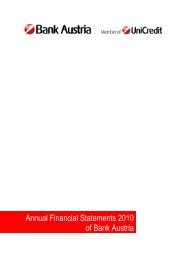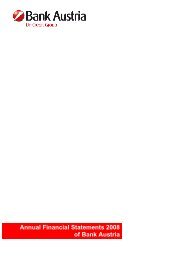Annual Financial Statements 2011 of Bank Austria
Annual Financial Statements 2011 of Bank Austria
Annual Financial Statements 2011 of Bank Austria
Create successful ePaper yourself
Turn your PDF publications into a flip-book with our unique Google optimized e-Paper software.
Consolidated <strong>Financial</strong> <strong>Statements</strong> in accordance with IFRSs<br />
E – Risk report (CoNTINuED)<br />
Implementation <strong>of</strong> disclosure requirements pursuant to Sections 26 and 26a <strong>of</strong> the <strong>Austria</strong>n <strong>Bank</strong>ing Act<br />
(regular disclosure <strong>of</strong> information on the organisational structure, risk management and risk capital position pursuant to<br />
Sections 2 to 15 <strong>of</strong> the <strong>Austria</strong>n Disclosure Regulation)<br />
Within UniCredit Group, comprehensive disclosure (under the Pillar 3 disclosure requirements) is carried out by the parent company UniCredit on its<br />
website, based on the consolidated financial position in its function as EEA parent bank <strong>of</strong> <strong>Bank</strong> <strong>Austria</strong>. <strong>Bank</strong> <strong>Austria</strong> is a significant subsidiary pursuant<br />
to Section 26 (4) <strong>of</strong> the <strong>Austria</strong>n <strong>Bank</strong>ing Act and therefore discloses its supervisory capital structure (Section 4 <strong>of</strong> the <strong>Austria</strong>n Disclosure Regulation)<br />
and its capital adequacy requirement (Section 5 <strong>of</strong> the <strong>Austria</strong>n Disclosure Regulation); furthermore, the bank discloses information regarding<br />
the use <strong>of</strong> own estimates for volatility adjustments (comprehensive method) for credit risk mitigation techniques to take account <strong>of</strong> financial collateral<br />
pursuant to Section 17 <strong>of</strong> the <strong>Austria</strong>n Disclosure Regulation and in accordance with the approval by the <strong>Austria</strong>n <strong>Financial</strong> Market Authority (FMA).<br />
The disclosure by <strong>Bank</strong> <strong>Austria</strong> is available at its website www. bankaustria.at/Investor Relations/Basel II Disclosure Pillar 3.<br />
Current status <strong>of</strong> Basel 2.5/Basel 3 implementation in the <strong>Bank</strong> <strong>Austria</strong> Group<br />
Market risk in the trading book:<br />
The EU rules in the Capital Requirements Directive (CRD III) – which have been adapted in respect <strong>of</strong> their first-time application, postponing it to the<br />
end <strong>of</strong> <strong>2011</strong> – have imposed significantly stricter capital requirements on European banks. The main changes relating to the trading book are the new<br />
concepts <strong>of</strong> stressed VaR, incremental risk charge (IRC) and the new requirements concerning structured securitisations (the latter are not applied in<br />
UniCredit <strong>Bank</strong> <strong>Austria</strong> for lack <strong>of</strong> relevant positions in the trading book). As at year-end <strong>2011</strong>, capital requirements for “stressed VaR” and “incremental<br />
risk charge” were for the first time calculated and covered as part <strong>of</strong> market risk for the <strong>Bank</strong> <strong>Austria</strong> Group. A reporting procedure for these<br />
new parameters was set up in MACO, which meets once a week. Moreover, separate IRC limits were introduced for the relevant risk-takers in the<br />
<strong>Bank</strong> <strong>Austria</strong> Group. At the global level, besides detailed VaR limits, an S-VaR limit was also implemented for the regulatory trading book<br />
Counterparty risk:<br />
Changes will also take place in the area <strong>of</strong> counterparty credit risk; from a current perspective, these changes will need to be implemented by the end<br />
<strong>of</strong> 2012. Key changes include the calculation <strong>of</strong> a stressed counterparty exposure, comparable to the stressed VaR in market risk. Other new features<br />
are the capital backing for market risk in respect <strong>of</strong> credit valuation adjustments (CVA market risk charge), stricter standards for collateral management<br />
and margining. The treatment <strong>of</strong> central counterparties, which act as clearing centres, is also regulated in the Basel Committee proposals and/or was<br />
set out in more detail in the course <strong>of</strong> <strong>2011</strong> in CAD IV, which is now available. This applies, for example, to the implementation <strong>of</strong> stress analyses and<br />
regular reviews <strong>of</strong> model quality as part <strong>of</strong> backtesting.<br />
Liquidity:<br />
Basel 3 sets liquidity standards under stressed conditions in the short-term maturity range (liquidity coverage ratio = 100%) and in the structural<br />
sector (net stable funding ratio = 1). Although compliance with these rules will not be mandatory before 2015 and 2018, respectively, <strong>Bank</strong> <strong>Austria</strong><br />
made the necessary extensions to the liquidity monitoring system in the course <strong>of</strong> <strong>2011</strong> and integrated the new regulatory standards in the current<br />
management information process.<br />
E.2 – Market risk<br />
Market risk management encompasses all activities in connection with our Markets & Investment <strong>Bank</strong>ing operations and management <strong>of</strong> the balance<br />
sheet structure in Vienna and at <strong>Bank</strong> <strong>Austria</strong>’s subsidiaries. Risk positions are aggregated at least daily, analysed by the independent risk management<br />
unit and compared with the risk limits set by the Management Board and the committees (including MACO) designated by the Management<br />
Board. At <strong>Bank</strong> <strong>Austria</strong>, market risk management includes ongoing reporting on the risk position, limit utilisation, and the daily presentation <strong>of</strong> results <strong>of</strong><br />
all positions associated with market risk. Most <strong>of</strong> the positions held in <strong>Bank</strong> <strong>Austria</strong> are attributable to the banking book as <strong>Bank</strong> <strong>Austria</strong> continued to<br />
reduce positions attributable to the trading book in the course <strong>of</strong> <strong>2011</strong>. Market risk <strong>of</strong> the banking book is an important factor also in other Divisions<br />
(the CEE banking subsidiaries, in particular). UniCredit <strong>Bank</strong> <strong>Austria</strong> uses uniform risk management procedures for all market risk positions throughout<br />
the Group. These procedures provide aggregate data and make available the major risk parameters for the various trading operations once a day.<br />
Besides Value at Risk (VaR), other factors <strong>of</strong> equal importance are stress-oriented sensitivity and position limits. Additional elements <strong>of</strong> the limit system<br />
are loss-warning and stress-warning levels.<br />
In April <strong>2011</strong>, <strong>Bank</strong> <strong>Austria</strong> AG was granted permission by the <strong>Austria</strong>n supervisory authorities to use the new IMOD model, which is applied within the<br />
entire UniCredit Group, for the purpose <strong>of</strong> limiting market risk. The new model has been used for reporting regulatory capital requirements since the<br />
end <strong>of</strong> April <strong>2011</strong>. The new model is based on historical simulation with a 500-day market data time window for scenario generation. It is currently<br />
used on a uniform basis by many UniCredit Group subsidiaries. The model is applied by Market Risk and Risk Integration within <strong>Bank</strong> <strong>Austria</strong> and is<br />
being further developed in cooperation with the UniCredit holding company. Further development includes reviewing the model as part <strong>of</strong> backtesting<br />
procedures, integrating new products, implementing requirements specified by the Management Board and the Market Risk Committee, and adjusting<br />
the model to general market developments.<br />
<strong>Bank</strong> <strong>Austria</strong> · <strong>Annual</strong> <strong>Financial</strong> <strong>Statements</strong> <strong>2011</strong><br />
138
















